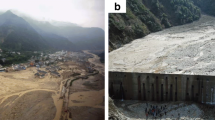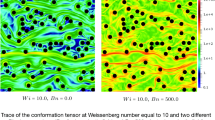Abstract
Changes in direction and cross section in supercritical hydraulic channels generate shockwaves which result in an increase in flow depth with regard to that for uniform regime. These disturbances are propagated downstream and need to be considered in the design of the chute walls. In dam spillways, where flow rates are often high, this phenomenon can have significant implications for the cost and complexity of the solution. It has been traditionally analysed by means of reduced-scale experimental tests, as it has a clear three-dimensional character and therefore cannot be approached with two-dimensional numerical models. In this work, the ability of the particle finite element method (PFEM) to reproduce this phenomenon is analysed. PFEM has been successfully applied in previous works to problems involving high irregularities in free surface. First, simple test cases available in the technical bibliography were selected to be reproduced with PFEM. Subsequently, the method was applied in two spillways of real dams. The results show that PFEM is capable of capturing the shockwave fronts generated both in the contractions and in the expansions that occur behind the spillway piers. This suggests that the method may be useful as a complement to laboratory test campaigns for the design and hydraulic analysis of dam spillways with complex geometries.



Adapted from [5]


Adapted from [24]














Similar content being viewed by others
References
Aubry R, Idelsohn S, Oñate E (2005) Particle finite element method in fluid-mechanics including thermal convection–diffusion. Comput Struct 83(17–18):1459–1475
Bayon A, Valero D, García-Bartual R, López-Jiménez PA et al (2016) Performance assessment of openfoam and flow-3d in the numerical modeling of a low reynolds number hydraulic jump. Environ Model Softw 80:322–335
Carbonell JM, Oñate E, Suárez B (2009) Modeling of ground excavation with the particle finite-element method. J Eng Mech 136(4):455–463
Chanson H (1993) Stepped spillway flows and air entrainment. Can J Civ Eng 20(3):422–435
Chow V (1959) Open-channel hydraulics. McGraw-Hill, New York
Edelsbrunner H, Mücke EP (1994) Three-dimensional alpha shapes. ACM Trans Graph 13(1):43–72
Idelsohn S, Mier-Torrecilla M, Oñate E (2009) Multi-fluid flows with the particle finite element method. Comput Methods Appl Mech Eng 198(33):2750–2767
Idelsohn S, Oñate E, Del Pin F (2003) A lagrangian meshless finite element method applied to fluid–structure interaction problems. Comput Struct 81(8):655–671
Idelsohn S, Oñate E, Pin FD (2004) The particle finite element method: a powerful tool to solve incompressible flows with free-surfaces and breaking waves. Int J Numer Methods Eng 61(7):964–989
Larese A, Rossi R, Oñate E, Idelsohn SR (2008) Validation of the particle finite element method (PFEM) for simulation of free surface flows. Eng Comput 25(4):385–425
Lian J, Qi C, Liu F, Gou W, Pan S, Ouyang Q (2017) Air entrainment and air demand in the spillway tunnel at the Jinping-I dam. Appl Sci 7(9):930
Nadukandi P, Servan-Camas B, Becker PA, Garcia-Espinosa J (2017) Seakeeping with the semi-lagrangian particle finite element method. Comput Part Mech 4(3):321–329
Oñate E, Idelsohn SR, Celigueta MA, Rossi R (2008) Advances in the particle finite element method for the analysis of fluid–multibody interaction and bed erosion in free surface flows. Comput Methods Appl Mech Eng 197(19):1777–1800
Oñate E, Rossi R, Idelsohn SR, Butler KM (2010) Melting and spread of polymers in fire with the particle finite element method. Int J Numer Methods Eng 81(8):1046–1072
Oñate E, Celigueta MA, Idelsohn SR (2006) Modeling bed erosion in free surface flows by the particle finite element method. Acta Geotech 1(4):237–252
Oñate E, Celigueta MA, Idelsohn SR, Salazar F, Suárez B (2011) Possibilities of the particle finite element method for fluid–soil–structure interaction problems. Comput Mech 48(3):307–318
Oñate E, Franci A, Carbonell JM (2014) Lagrangian formulation for finite element analysis of quasi-incompressible fluids with reduced mass losses. Int J Numer Methods Fluids 74(10):699–731
Oñate E, Franci A, Carbonell JM (2014) A particle finite element method for analysis of industrial forming processes. Comput Mech 54(1):85–107
Oñate E, Idelsohn S (2004) The particle finite element method. An overview. Int J Comput Methods 1:267–307
Pozo D, Salazar F, Toledo M (2014) Modeling the hydraulic performance of the aeration system in dam bottom outlets using the particle finite element method. Revista Internacional de Métodos Numéricos para Cálculo y Diseño en Ingeniería 30(1):51–59 (in Spanish)
Reinauer R (1995) Kanalkontraktionen bei schiessendem abfluss und stosswellenreduktion mit diffraktoren. Ph.D. thesis, ETH Zurich
Reinauer R, Hager WH (1994) Supercritical flow behind chute piers. J Hydraul Eng 120(11):1292–1308
Reinauer R, Hager WH (1997) Supercritical bend flow. J Hydraul Eng 123(3):208–218
Reinauer R, Hager WH (1998) Supercritical flow in chute contraction. J Hydraul Eng 124(1):55–64
Salazar F, Irazábal J, Larese A, Oñate E (2016) Numerical modelling of landslide-generated waves with the particle finite element method (PFEM) and a non-Newtonian flow model. Int J Numer Anal Meth Geomech 40:809–826. https://doi.org/10.1002/nag.2428
Salazar F, Morán R, Rossi R, Oñate E (2013) Analysis of the discharge capacity of radial-gated spillways using CFD and ANN-Oliana Dam case study. J Hydraul Res 51(3):244–252
Salazar F, Oñate E, Morán R (2012) Numerical modelling of landslides in reservoirs via the particle finite element method (PFEM). Revista Internacional de Métodos Numéricos para Cálculo y Diseño en Ingeniería 28(2):112–123 (in Spanish)
Salazar F, San-Mauro J, Celigueta MÁ, Oñate E (2017) Air demand estimation in bottom outlets with the particle finite element method. Comput Part Mech 4(3):345–356. https://doi.org/10.1007/s40571-016-0117-4
Saunders K, Prakash M, Cleary PW, Cordell M (2014) Application of smoothed particle hydrodynamics for modelling gated spillway flows. Appl Math Model 38(17–18):4308–4322
Teng P, Yang J (2018) Modeling and prototype testing of flows over flip-bucket aerators. J Hydraul Eng 144(12):04018069
USBR: El vado dam—service spillway modification—physical model study. Technical report HL-2017-02 (2017)
Valero D, Bung DB, Crookston BM (2018) Energy dissipation of a type III basin under design and adverse conditions for stepped and smooth spillways. J Hydraul Eng 144(7):04018036
Valiani A, Caleffi V (2005) Brief analysis of shallow water equations suitability to numerically simulate supercritical flow in sharp bends. J Hydraul Eng 131(10):912–916
Vischer D, Hager WH, Cischer D (1998) Dam hydraulics, vol 2. Wiley, Chichester
Xue H, Diao M, Ma Q, Sun H (2018) Hydraulic characteristics and reduction measure for rooster tails behind spillway piers. Arab J Sci Eng 43(10):5597–5604
Yang J, Andreasson P, Teng P, Xie Q (2019) The past and present of discharge capacity modeling for spillways—a swedish perspective. Fluids 4(1):10
Zienkiewicz O, Ortiz P (1995) A split-characteristic based finite element model for the shallow water equations. Int J Numer Methods Fluids 20(8–9):1061–1080
Zienkiewicz OC, Taylor RL (2005) The finite element method for solid and structural mechanics. Butterworth-Heinemann, Oxford
Acknowledgements
The research was supported by the Spanish Ministry of Economy and Competitiveness (Ministerio de Economía y Competitividad, MINECO) through the Project CALA (RTC-2016-4581-5).
Author information
Authors and Affiliations
Corresponding author
Ethics declarations
Conflict of interest
On behalf of all the authors, the corresponding author states that there is no conflict of interest.
Additional information
Publisher's Note
Springer Nature remains neutral with regard to jurisdictional claims in published maps and institutional affiliations.
Rights and permissions
About this article
Cite this article
Salazar, F., San-Mauro, J., Celigueta, M.Á. et al. Shockwaves in spillways with the particle finite element method. Comp. Part. Mech. 7, 87–99 (2020). https://doi.org/10.1007/s40571-019-00252-1
Received:
Revised:
Accepted:
Published:
Issue Date:
DOI: https://doi.org/10.1007/s40571-019-00252-1




